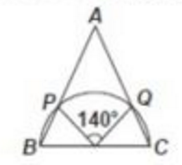Triangle, Circles, Angles

is the diameter of a semi-circle. The sides of and of a triangle meet the semi-circle in and respectively. subtends at the centre of the semi-circle. Then is equal to:
(A)
.
(B)
.
(C)
.
(D)
.
This section requires Javascript.
You are seeing this because something didn't load right. We suggest you, (a) try
refreshing the page, (b) enabling javascript if it is disabled on your browser and,
finally, (c)
loading the
non-javascript version of this page
. We're sorry about the hassle.
Let the centre of the semi circle be O
Now, as angle QOC=POB and POB+QOC+POQ=180°
=>QOC=(180°-140°)/2 = 20° In ∆QOC angle OQC = OCQ (Because opposite side OQ and OC are equal)
Also OQC + OCQ + QOC = 180°
=>OQC = (180° - QOC)/2 = 80°
Now as angle OQC + OQA = 180°
=> OQA = 180° - 80° = 100°
Now in quadrilateral OQAP, OQA+QAP+APQ+POQ=360°
=>2(OQA) + 140° + QAP = 360°. (OQA = OPA and POQ=140°)
=>QAP= 360°-200°-140°=20°
As QAP = A
Hence the answer is 20°